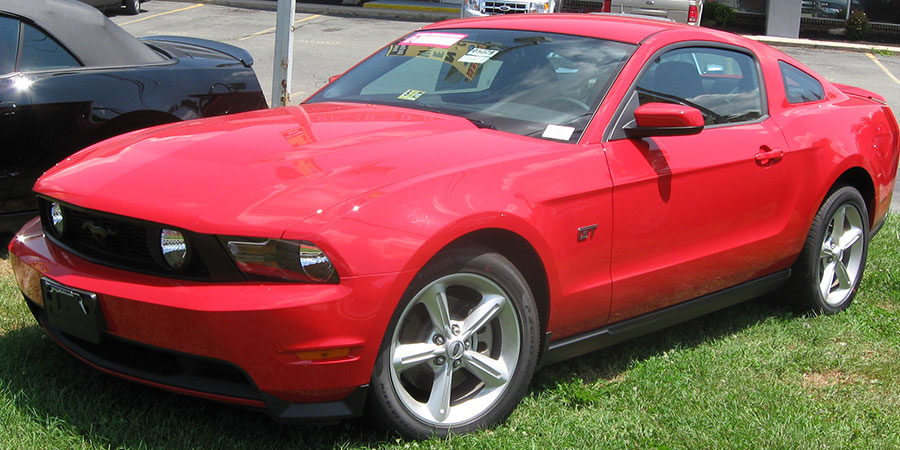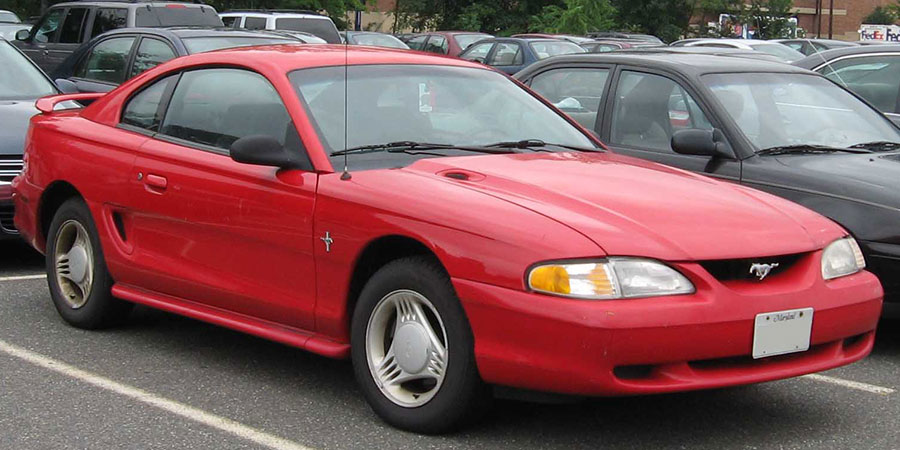The Ford Mustang is a sports car with a beautiful design every year. This car has improved time and time again to deliver the best performance possible. We are going to look at the past and current generations of this sports car, diving into the details of its updates and history. If you want a classic sports car that’s recognized for its style and performance everywhere, keep reading.
Key Takeaways:
- The Ford Mustang is a classic sports car that consistently improves its performance and power.
- Many Mustang generations take inspiration from the 60’s for style and design.
- MSRP for seventh generation Mustangs range from roughly $30,000-$70,000.
Seventh generation 2024-Present

The Mustang continues its tradition of excellence in this seventh generation. Since its debut in the 60’s, Ford has continued to adapt and improve the Mustang with more power, greater tech, and enough variety to keep everyone happy. The introduction of this generation opened with the addition of the “Dark Horse” Series.
The seventh generation comes with a variety of trim options available: The Ecoboost Coupe, The Ecoboost Premium Coupe, Ecoboost Convertible, Ecoboost Premium Convertible, GT Coupe, GT Premium Coupe, GT Premium Convertible, Dark Horse Coupe, and the Dark Horse Premium Coupe. The MSRP for these Mustangs range from $33,515-$69,870, depending on the trim, year, and options.
Throughout this lineup, there are 3 powertrain options available.
- The base powertrain is a turbocharged 2.3-liter four-cylinder Ecoboost engine. This engine is rated at 315 horsepower and 350 lb.-ft. of torque with an automatic 10-speed transmission.
- A 5.0-liter V-8 is the heart of the Mustang with a rating of 480 horsepower and 415 lb.-ft. of torque. This engine is paired with a 10-speed automatic transmission as well, or a six-speed manual transmission, which is much preferred for better control and speed. An optional performance exhaust that’s available increases the output to 486 horsepower and 418 lb.-ft. of torque.
- The Dark Horse trim uses a 500-horsepower version of the 5.0-liter V-8.
The 2025 Ford Mustang will bring cosmetic updates including 20-inch wheels with red center caps for their GT Coupes and convertibles. This 60th anniversary year also brings a digital gauge cluster as a throwback to the 1967 Mustang.
Sixth generation 2015-2023

This generation of Mustangs featured changes to the body for a more modern cosmetic look and better performance. The body was widened by 1.5 inches and lowered by 1.4 inches, a new grille was added, and a 2.75-inch lower decklid was added.
A newly developed 2.3-liter four-cylinder Ecoboost with 310 horsepower, a 3.7-liter 300 horsepower V-6, and a 5.0-liter Coyote V-8 with 435 horsepower with a six-speed manual or automatic transmission became available.
The changes that Ford made throughout this generation are:
- 2018: A minor redesign to the exterior and the engine was revised. The 2.3-liter Ecoboost became the base option for the Mustang. The 5.0-liter V-8 gets more power leading to 460 horsepower. Both engines are equipped with an automatic 10-speed transmission.
- 2019: Ford revised steering components, suspension components, and the tires of the 2019 Shelby GT350.
- 2020: Brought the re-introduction of the GT500 with a 5.2-liter aluminum-alloy V-8 engine with 760 horsepower. The GT350 was discontinued at the end of 2020.
- 2021: Ford re-introduces the Mach 1.
Fifth Generation 2005-2022
The fifth-generation Mustang’s style draws from the past taking inspiration from the Mustangs of the late 60’s. This new look was called “retro-futuristic" boasting a near-wedge profile. This generation includes several special editions such as the 2008-2009 Bullitt, the 2012-2013 Boss 302, and the famous Shelby GT500 that’s been available since 2007.
Multiple revisions were made to this generation through its years, those were:
- 2007: Ford launched the Shelby GT500.
- 2010: The Mustang showed a redesigned exterior with sequential LED tail lights and a reduced drag coefficient on the base and GT models. The GT’s engine was updated to bring 315 horsepower. New spring rates, dampers, traction and stability control, and wheel sizes were updated.
- 2011: Transmission options included a six-speed automatic and manual transmission and a new aluminum block 3.72-liter V-6 engine weighed 40 lbs less than the previous version and it came with a new dual exhaust. Brembo brakes were optional and 19-inch wheels with performance tires.
- 2012: The new Mustang Boss 302 version was introduced. The Shelby GT500 was given a new supercharged 5.8-liter V-8 with 662 horsepower. Both the Shelby and Boss engines came with a six-speed manual transmission. Styling updates included the grille and air intakes, and the decklid received a black panel on all trim levels. The GT’s 5.0-liter V-8 went from 412 horsepower to 420 horsepower.
Fourth generation 1994-2004
The new styling from this generation brought many cues from earlier Mustangs. The notchback coupe model was not available for the first time since 1964 and the door windows were frameless.
The base model came with a 3.8-liter V-6 OHV. This generation also brought three new models, the 2001 Bullitt, and the 2003 and 2004 Mach 1.
As technology improved through these years, so did the design of the Mustang including:
- 1999: The Mustang was redesigned with sharper edges, larger wheel arches, and creases in its bodywork. The standard 3.8-liter V-6 got a new split-port induction system, and the GT’s 4.6-liter V-8 increased its bhp to 260.
- 2001: The 3.8-liter increased to 193 bhp.
- 2004: the standard 3.8-liter V-6 was replaced with a 3.9-liter variant of the Essex engine.
Third Generation 1979-1993
The third-generation Mustang was built using Ford’s Fox platform. The Mustang convertible returned in this third generation, and the hardtop, coupe, and liftback versions. Multiple trim options were available including the SVO, SVT Cobra, SVT Cobra R, Ghia, Cobra, L, GL, GLX, GT, Turbo GT, LX, and the GT350 20th anniversary edition. An automatic and manual transmission were offered for various inline-four, V-6, and V-8 engines.
This Mustang’s generation saw two different front-end styles, from 1979 to 1986 the front end was angled back using four rectangular headlights, this became referred to as “four eyes” The front end was restyled in the later years of this generation to have a rounded-off style and a smooth grille-less nose.
Ford continued to update and improve these designs, here are the updates from this generation:
- 1982: The Mustang GT returned replacing the Cobra.
- 1983: The Mustang convertible returned and the front fascias of all Mustangs were restyled sporting Ford’s “Blue Oval” for the first time.
- 1984: The high-performing Mustang SVO was introduced with a 2.3-liter turbocharged four-cylinder engine
- 1987: The Mustang interior and exterior were majorly restyled which carried through to the end of this generation.
Second Generation 1974-1978
The Mustang received major updates in its second generation leading to a smaller car that was also heavier because of the extra equipment needed to pass emission and safety regulations. Its smaller size allowed the Mustang to compete against successful imported sports coupes.
The updates made throughout this generation helped keep Mustangs up to date and to bring top-of-the-line power, those updates were:
- 1975: Reintroduced the Windsor V-8 which was only available with the C-4 automatic transmission. Power brakes and power steering were also reintroduced. The availability of an “MPG” model was introduced with a different rear axle ratio for better fuel economy.
- 1976: The Stallion trim package was added. Additional changes were made to the Cobra II to update its appearance and performance.
- 1977: Hatchback models in all trim levels of the Mustang were now available.
First generation 1965-1973
The First generation Ford Mustang was sold to the public on April 14, 1964. The design included a two-door hardtop and a convertible with a fastback added. Throughout this generation the Mustang got bigger and allowed a large block engine for the first time.
The updates Ford added to the Mustang in this generation was:
- 1967: Included an energy-absorbing steering column and wheel, a dual circuit hydraulic braking system, softer interior knobs, and four-way emergency flashers.
- 1968: Had revised side scoops, steering wheel, and gas caps. This year, a new 4.9-liter V-8 engine was also introduced.
- 1969: New quad headlamps were featured. 1969 was the last year for the GT option.
- 1970: The quad headlamps were removed to make way for a wider grille and standard headlamps.
A Legacy of style and innovation.
The Ford Mustang has been a classic from the very beginning. It remains a high-end sports car delivering a luxurious and sporty feeling. Its power and performance are enhanced year after year. Visit Jarrett Ford today and we will help you find the right car to match your needs and take you on your next adventure.